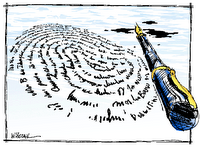
I haven't been paying much attention to developments regarding the Wechsler Adult Intelligence Scale--Fourth Edition (WAIS IV), so today I took a peak. Information is available at the publishers web site. Projected availability is summer 2008.

 Registration for the The Third National School Neuropsychology Conference (July 9-12; Grapevine, Texas) is now open. It looks like a very good conference with presentations/workshops on the NEPSY-II, CHC cross-battery assessment, the CAS, working memory assessment, the D-KEFS, culturally and linguistically oriented assessment, LD/RTI, etc.
Registration for the The Third National School Neuropsychology Conference (July 9-12; Grapevine, Texas) is now open. It looks like a very good conference with presentations/workshops on the NEPSY-II, CHC cross-battery assessment, the CAS, working memory assessment, the D-KEFS, culturally and linguistically oriented assessment, LD/RTI, etc. Interested in the cognitive neuropsychological research in the area of musical abilities and perception? Check out special issue of Music Perception mentioned at the IQ Brain Clock blog.
Interested in the cognitive neuropsychological research in the area of musical abilities and perception? Check out special issue of Music Perception mentioned at the IQ Brain Clock blog. This weeks recent literature of interest can be found by clicking here.
This weeks recent literature of interest can be found by clicking here. This weeks recent literature of interest can be found by clicking here.
This weeks recent literature of interest can be found by clicking here. This weeks (actually, the last two weeks) recent literature of interest can be found by clicking here.
This weeks (actually, the last two weeks) recent literature of interest can be found by clicking here.
Book Reviews | |
| 1. | Contingency Management in Substance Abuse Treatment Authors: Stephen T. Higgins, Kenneth Silverman, and Sarah H. Heil (Eds.) Reviewers: Mark S. Gold and Lisa J. Merlo |
| 2. | The Gestural Origin of Language Authors: David F. Armstrong and Sherman E. Wilcox Reviewer: Jason T. Ramsay |
| 3. | Rise and Shine: Sunlight, Technology and Health Author: Simon Carter Reviewers: Anne Moyer and Sarah K. Knapp |
| 4. | Socioemotional Development in the Toddler Years: Transitions and Transformations Authors: Celia A. Brownell and Claire B. Kopp (Eds.) Reviewer: Bruce B. Henderson |
| 5. | Internships: Theory and Practice Authors: Charles H. Sides and Ann Mrvica Reviewer: Patricia L. Wolleat |
| 6. | Criminal Profiling: International Theory, Research, and Practice Author: Richard N. Kocsis (Ed.) Reviewer: David L. Shapiro |
| 7. | Working Memory, Thought, and Action Author: Alan Baddeley Reviewer: David W. Carroll |
| 8. | Coercion as Cure: A Critical History of Psychiatry Author: Thomas S. Szasz Reviewer: Jay Joseph |
| 9. | Paying the Tab: The Costs and Benefits of Alcohol Control Author: Philip J. Cook Reviewer: Eugene H. Rubin |
| 10. | Hypothetical Thinking: Dual Processes in Reasoning and Judgement Author: Jonathan St. B. T. Evans Reviewer: Christopher A. Was |
| 11. | Taking America Off Drugs: Why Behavioral Therapy is More Effective for Treating ADHD, OCD, Depression, and Other Psychological Problems Author: Stephen Ray Flora Reviewers: Christina S. McCrae and Daniel B. Kay |
Film Review | |
| 12. | Once Director: John Carney Reviewer: Theresa A. Thorkildsen |